The Feathered Bough – Stephen J. Clark
A Suggestion of Ghosts – Supernatural Fiction by Women 1854-1900
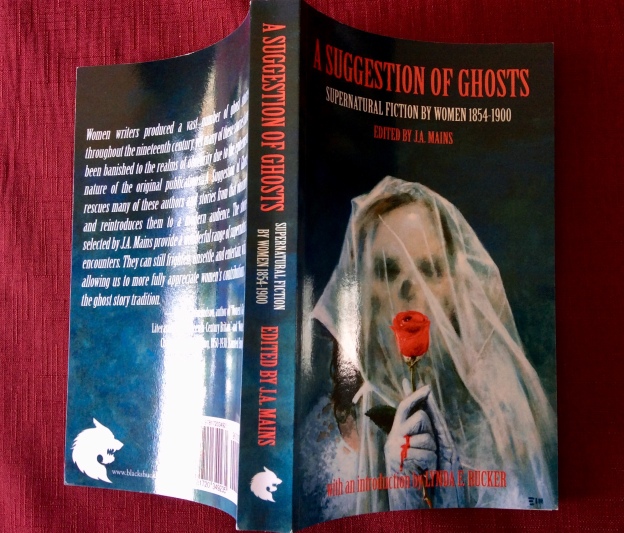
Edited by J.A. Mains in 2017
BLACK SHUCK BOOKS
Introduction by Lynda E. Rucker
Stories by Susanna Moodie, Frances Power Cobbe, Georgiana S. Hull, Phoebe Pember, Clara Merwin, E.A. Henty, Manda L. Crocker, Ada Maria Jocelyn, Annie Trumbull Slosson, Lady Gwendolen Gascoyne-Cecil, Mary Eleanor Wilkins Freeman, Katharine Tynan, Mrs Hattie H. Howard, Elizabeth Gilbert Cunningham-Terry, Annie Armitt.
My previous reviews of older or classic books HERE.
Whenever I read this book, my thoughts will appear in the comment stream below…

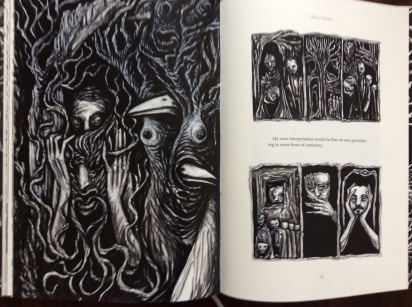
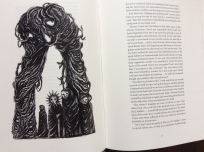
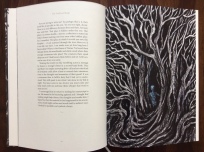
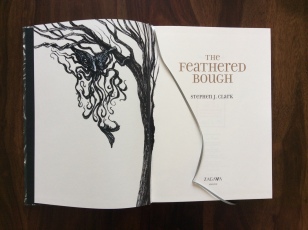
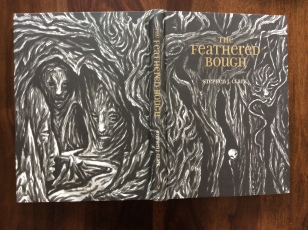


Hawled upwards from: https://dflewisreviews.wordpress.com/2018/06/08/the-feathered-bough-stephen-j-clark/#comment-12848
FROM A FORGOTTEN LAND
Dr Rudkin’s Journal
28 October 1954
“Words haunt the world.”
“; they instructed him in the form of prophecies. They told him he was to be their messenger…”
When I say there are scores of artwork items and when I also say they are frighteningly good, these are understatements. This is a major reading experience, one that is literally crammed with awe and, at first, in this early stage, with sublime fear. I am confident there has been nothing else like it. And needs to be eked out very slowly and handled with care.
I sense a journey begins here with the book evolving in your hand as its own story, a created labyrinth that, for ten years, in more humble ways, I have been, it seems, trying to do with gestalt dreamcatching or, as I call it, hawling, hawling the essence of many weird literature books in original English, especially from non-Uk Europe, that few others actually read. But, more likely, this book is some culmination beyond the scope of my own dreamcatching or critical thought, and it will exist ineluctably, whatever I do or say about it, as the Nerval agent is now implanted, and the bookmaker tells his doctor about it even as it evolves in real-time around them and its readers…
Or so I infer, so far. I may turn out to be wrong. Or overstating the case.
“In Featherbough it is the children who teach.”
I have decided that there is no point in transcribing section headings, but only page numbers. The headings are part of the whole experience and would give a wrong impression without the book in hand; here we have a refrain of Featherbough, “ritual games in which I piece together traces … “
A sense of a lost domain, travelling there, gestating or gestalting that there, by dint of words and images. And Rooks. The Tenacity of Feathers?
I hold by what I said yesterday above. If I need to change anything in what I said yesterday above, I will tell you. For good or ill. I wish I could photo each day’s images as I travel through. But I know I can’t. Only the book itself will do. The images that outspace the words, perhaps, are also deep dark, as well as tinted and indelible, beyond anything I have seen in a book before. Or anywhere else, for that matter. Ground-breaking when seen on paper.
“Did he create the imaginary world because he wanted others to share his vision and so bear his burden, too.”
This world – imaginary or not – is that of Nerval, patient inmate at the Colony, who says he is named after the more famous Nerval, the Colony that holds elderly dementia patients as well as young drug addicts where there seem to be two differing regimes of care, from whose two written-down points of view, Rudkin and Malfrey, we see Nerval’s scrapbook of writing and images, as well as seeing at least some of the contents themselves of the scrapbook directly, or what I assume to be his scrapbook, although Rudkin hints at connivance and collusion with Nerval, a collaborative gestalt of effort? How are we to know for certain? But where, I ask, does Stephen J. Clark figure in all this? A cover for it all? There is one image at least in this section of pages that literally draws you in… and I wonder what Old Man Machen would think of the scantily dressed images? And the morphed mugshots on page 42… what of them?
“The Great Rooks call you home to cross the Feathered Bough. They call you to enter these secret pages.”
And who or what is each reader in all of this? In the ‘everything at once’?
“Who could remain sane when suddenly they find that they have become everything at once,…”
I, too, have been accused of “lacking the rigour of shrewd historiography” in my reviews. So, what is this Clark’s Colony — Poe’s Tarr and Fether, John Cowper Powys’ ‘The Inmates’, Frank Kafka or Mark Samuels in Prozess, Mann’s Magic Mountain, Aickman’s The Hospice or Into The Wood…?
Meanwhile, the page-filling images continue to be literally stunning, staggering, darkly searing, with any “wings dipped in ink.”
“All that persists is the unyielding present, depleting the past and future.”
“I think of how those we’ve lost, in their own way, pass into the rumour and legend of ordinary lives and like ghosts persist in living memory.”
Mnemonic triggers, the ambivalence of the Great Rooks as adversary and mentor. The ambivalence of the Great Books, I’d add. The ambivalence of doctor and patient. The doctor’s private life (his own wife) as part of this positive synergy or mutual parasitism. The Null Immortalis (as I might call it) of such incarceration, the not being able to reach the next world.
“Man can no more dispense with myth than he can with words.”
“Under whose guiding hand did he limn those images? Who taught Nerval to draw?”
Some unknown Nerval agent? Meanwhile, each time I approach this book, I feel its allure and my own trepidation. I worry that I am myself being drawn ineluctably, and worry, too, that there are things I am missing from some real or imaginary or past-literary backstory. What of the poet Nerval himself, Hortus Palatinus, Beatrice / Aurélia, Rootskin, Mr Gentle &c. And the book’s in-your-face images worry, as well as entrance, me; indeed a few of of them terrify me! Perhaps Malfrey is my only potential fixed alliance in these shifting worries?
“; he’s as kind as sleep.”
Mr Gentle. I feel I am a version of Mr Gentle, but from outside this book. A sort of ferryman reviewer. Into deeper and deeper realms of Featherbough? Also a concept of a mask in the hand being worth two on the face? Mask in the hand as a guide … mask on the face as a spokesperson, if not you yourself?
Needless to say, this ferreview /ferryview can do no justice to the book’s text or images. But I shall persevere with this in real-time as I now seem somehow essential to this book! And it to me, I assume. A path I need to tread, having started it. So be warned. (I may repeat this in a sub-comment above.)
“The dead don’t often think about the living.”
Sections that resonate even further with the link to the other author above an hour or so ago. Towards a shape of water. Mask and Gentle.
There is no real point to this real-time review, as I have probably already said what I can about it, except it ever continues to prove itself increasingly even more worthy of what I have already said about it. I think this is the first time I have felt like this with any previous real-time review. A river that changes its name seamlessly between one stretch of it and the next. Where names begin and end without noticing. As well as our bodies. Shoals and shoals of unforgettable images.
Pages 100 – 110
“Yes, I may have mentioned Featherbough but in a sense it is all around us, its influence everywhere.”
…that I now have increasingly a sense of a sort of co-resonating Damian Murphy ritual path, with set steps, labels, indices, writing utensils, detached pages of a book swirling, codes and forthcoming names, towards an Oracle. A sense of occult meaning…
The pictorial images, meanwhile, continue to prevail, unlike any such in books before, even in scattered or dismembered ones, I guess.
“There are always cracks to be discovered in the structure; it is only ever a matter of how attentively one observes.”
That ‘one’ contains a multitude of sins, as it were. I continue to believe that an essential to this book’s meaning is attentiveness to the words of the polarised doctors Malfrey and Ruskin (bad cop and good cop respectively), Nerval’s words themselves, and those of Mr Gentle with whom I hope to have my own being as the gestalt real-time reviewer or ferryman, with an obsessive absorption of many highly charged books such as this one, like drinking from the waters of Lethe. Given my own ferry by the book itself this time. A sort of “comorbidity” (itself a word in this text) to transcend madness and visionary allegory. To untie knots or ligotti towards a final revelation?
Rudkin getting nearer to the patient’s artistic Nerval system?
Meanwhile literal-minded Malfrey imagines beyond his own imagination?
“I imagine all of those unsettled minds that have descended into the ground, as if they persist there still, their thoughts endlessly turning. Having been alone in the ground for so long I wonder if their madness has become even more complex. Does the contagion live on and contaminate the soil and the water too?”
Seems seminal, so quoted it all.
“We must become literate in the insular, enigmatic languages of the insane.”
As well as dealing in some serious way with how we handle the perceived insane, this is a veritable ambient fairground cruise through some ghost tunnel, but is far more classy and constructively silent than that! Or a special articulate sort of silence, with considerations of the concept MASKS that seems somehow associated with some of my earlier theories of Nemonymity…
Just two examples:
“Like the patient himself, the people Nerval portrayed were exiles in their own lives … dispossessed … even losing their own names.”
“I suspected he was interspersing new passages throughout those already finished so that I had to backtrack and re-examine what had gone before;”
This is what can happen with gestalt real-time reviewing. Not only here with doctor incorporated in the patient’s journey, but also the book incorporating its reviewer, too. See the example above of my interpolation into what I had already earlier written, by use of the sub-comment facility on this site!
The images continue to enthral. They are really in a class of their own.
The text is something to work at in the long term, as the themes I have already adumbrated continue to accrete alongside the images…
“Throughout the patients’s papers there were descriptions and drawings of migrants.”
As we read three separate sets of Rudkin Journal entries in a row, they also cross three separate chapters, the first one of which is actually called a Crossing. If you have Journal entries, do you also have Journal exits, too? How much of all this is patient-doctor collusive? How much of these visions and dreams and accounts actually relates to us as a metaphor of our times. Rudkin can’t tell us as his entries were written at the tail end of 1954. How much relates to his wife Beatrice, now in the Nerval name of Aurélia? And Malfrey, how much a means-justifying-the-ends Machiavelli of what is going on, and how much is Rudkin a darker-horse Ruskin? Only a whistleblower outside of this text could possibly judge. But I can only guess. A Journal kept as a testament to the reality of self is one thing. But a real-time review of a real-time review quite another!
“It was you, Rudkin, the boy was you as you were in childhood.”
Cf Proust.
In the longer term, I think this text has further secrets to divulge, without the need of its changing a single word of what is already printed among the images.
The Shock Room, included, as a device for healing madness. ECT that my father once suffered many years ago. Life itself is a fiction, as Rudkin arguably becomes a character in Nerval’s scrapbook. And Malfrey fears the same fate for himself…
— Allen Thiher (Link is to reference about his ‘Revels in madness: insanity in medicine and literature.’ And this quote and reference are mine not those of the book being reviewed.)
And: https://mathewfriley.com/2010/09/df-lewis-the-book-i-would-like-to-be-buried-with/
“…unnerving to witness.”
This is potentially the most disturbing book you will have ever read. And I do not say that lightly. Meanwhile, I am not sure I have been the perfect guide or ferryman, as Gentle. Nor do I think my interpretations and thoughts so far as sacrosanct forever. I shall certainly study it again …. after reading the author’s Afterword which I haven’t yet read and which — as is my wont, a wont as fed by my well-seasoned experience of the Intentional Fallacy — I have excluded from consideration in this review. The final pages seem extremely powerful and visionary, the words as well as the second-to-none images (images that alone should force you to experience this book even if words are not your normal passion). I end up dwelling on all my thoughts, and my views on overlapping, madness, medicine, shock treatment, weird literature, masks, archetypes, the avant garde and the names of characters, nemonymity, even my own name and whether I can remain discrete from the text itself! The names of Malfrey, Nerval, Fetch, Rudkin, Rootskin, Ruskin …
=============================